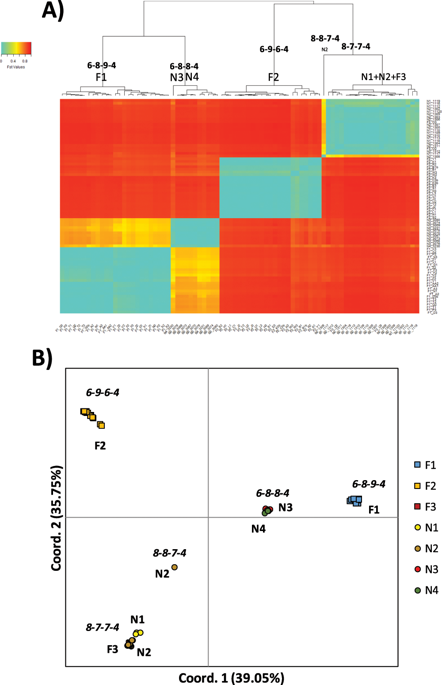Our official English website, www.x-mol.net, welcomes your
feedback! (Note: you will need to create a separate account there.)
Population-specific signatures of intra-individual mitochondrial DNA heteroplasmy and their potential evolutionary advantages.
Scientific Reports ( IF 3.8 ) Pub Date : 2020-01-14 , DOI: 10.1038/s41598-019-56918-6 Yaron Tikochinski 1 , Carlos Carreras 2 , Gili Tikochinski 3 , Sibelle T Vilaça 4, 5, 6
Scientific Reports ( IF 3.8 ) Pub Date : 2020-01-14 , DOI: 10.1038/s41598-019-56918-6 Yaron Tikochinski 1 , Carlos Carreras 2 , Gili Tikochinski 3 , Sibelle T Vilaça 4, 5, 6
Affiliation

|
Heteroplasmy is the existence of more than one mitochondrial DNA (mtDNA) variant within a cell. The evolutionary mechanisms of heteroplasmy are not fully understood, despite being a very common phenomenon. Here we combined heteroplasmy measurements using high throughput sequencing on green turtles (Chelonia mydas) with simulations to understand how heteroplasmy modulates population diversity across generations and under different demographic scenarios. We found heteroplasmy to be widespread in all individuals analysed, with consistent signal in individuals across time and tissue. Significant shifts in haplotype composition were found from mother to offspring, signalling the effect of the cellular bottleneck during oogenesis as included in the model. Our model of mtDNA inheritance indicated that heteroplasmy favoured the increase of population diversity through time and buffered against population bottlenecks, thus indicating the importance of this phenomenon in species with reduced population sizes and frequent population bottlenecks like marine turtles. Individuals with recent haplotypes showed higher levels of heteroplasmy than the individuals with ancient haplotypes, suggesting a potential advantage of maintaining established copies when new mutations arise. We recommend using heteroplasmy through high throughput sequencing in marine turtles, as well as other wildlife populations, for diversity assessment, population genetics, and mixed stock analysis.
中文翻译:

个体内线粒体DNA异质性的群体特异性特征及其潜在的进化优势。
异质性是指细胞内存在多个线粒体DNA(mtDNA)变体。尽管这是一个非常普遍的现象,但对异质性的进化机制还没有完全了解。在这里,我们结合使用高通量测序对绿海龟(Chelonia mydas)进行的异质性测量与模拟相结合,以了解异质性如何调节不同世代和不同人口场景下的种群多样性。我们发现异质性在所分析的所有个体中均很普遍,跨时间和组织的个体中信号一致。发现单倍型组成的显着变化是从母亲到后代,表明该模型包括卵子发生过程中细胞瓶颈的影响。我们的mtDNA遗传模型表明,异质性有利于随着时间的推移增加种群多样性,并可以缓解种群瓶颈,从而表明这种现象在种群数量减少和种群瓶颈频繁的物种(如海龟)中的重要性。具有最新单倍型的个体显示出比具有古老单倍型的个体更高的异质性水平,这表明当出现新的突变时,保持既定拷贝的潜在优势。我们建议在海龟以及其他野生动植物种群中通过高通量测序使用异质性进行多样性评估,种群遗传和混合种群分析。因此表明了这种现象在种群数量减少和种群瓶颈频繁的物种(如海龟)中的重要性。具有最新单倍型的个体显示出比具有古老单倍型的个体更高的异质性水平,这表明当出现新的突变时,保持既定拷贝的潜在优势。我们建议在海龟以及其他野生动植物种群中通过高通量测序使用异质性进行多样性评估,种群遗传和混合种群分析。因此表明了这种现象在种群数量减少和种群瓶颈频繁的物种(如海龟)中的重要性。具有最新单倍型的个体显示出比具有古老单倍型的个体更高的异质性水平,这表明当出现新的突变时,保持既定拷贝的潜在优势。我们建议在海龟以及其他野生动植物种群中通过高通量测序使用异质性进行多样性评估,种群遗传和混合种群分析。
更新日期:2020-01-14
中文翻译:

个体内线粒体DNA异质性的群体特异性特征及其潜在的进化优势。
异质性是指细胞内存在多个线粒体DNA(mtDNA)变体。尽管这是一个非常普遍的现象,但对异质性的进化机制还没有完全了解。在这里,我们结合使用高通量测序对绿海龟(Chelonia mydas)进行的异质性测量与模拟相结合,以了解异质性如何调节不同世代和不同人口场景下的种群多样性。我们发现异质性在所分析的所有个体中均很普遍,跨时间和组织的个体中信号一致。发现单倍型组成的显着变化是从母亲到后代,表明该模型包括卵子发生过程中细胞瓶颈的影响。我们的mtDNA遗传模型表明,异质性有利于随着时间的推移增加种群多样性,并可以缓解种群瓶颈,从而表明这种现象在种群数量减少和种群瓶颈频繁的物种(如海龟)中的重要性。具有最新单倍型的个体显示出比具有古老单倍型的个体更高的异质性水平,这表明当出现新的突变时,保持既定拷贝的潜在优势。我们建议在海龟以及其他野生动植物种群中通过高通量测序使用异质性进行多样性评估,种群遗传和混合种群分析。因此表明了这种现象在种群数量减少和种群瓶颈频繁的物种(如海龟)中的重要性。具有最新单倍型的个体显示出比具有古老单倍型的个体更高的异质性水平,这表明当出现新的突变时,保持既定拷贝的潜在优势。我们建议在海龟以及其他野生动植物种群中通过高通量测序使用异质性进行多样性评估,种群遗传和混合种群分析。因此表明了这种现象在种群数量减少和种群瓶颈频繁的物种(如海龟)中的重要性。具有最新单倍型的个体显示出比具有古老单倍型的个体更高的异质性水平,这表明当出现新的突变时,保持既定拷贝的潜在优势。我们建议在海龟以及其他野生动植物种群中通过高通量测序使用异质性进行多样性评估,种群遗传和混合种群分析。

































 京公网安备 11010802027423号
京公网安备 11010802027423号